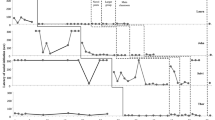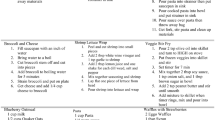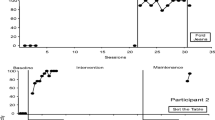Abstract
Newly developed technologies are being incorporated into treatments for children with autism but there is only limited research examining how this affects child outcomes. In the present study, a multiple baseline design across children and an adapted alternating treatments design within child were used to compare the effectiveness of video modeling interventions implemented on the iPad® to video modeling interventions implemented on the traditionally used television. Two targets were selected for each child and behaviors were randomly assigned to a treatment condition. Target behaviors were acquired and these behavior changes were found to be socially valid across treatment conditions. Four of the children required slightly more treatment sessions to acquire behaviors targeted on the iPad®. Generalization and maintenance were slightly higher following video modeling on the iPad®, but differences were inconsistent and unlikely to result in meaningfully different outcomes. These findings indicate that video modeling on the iPad® does not result in improved child progress compared to traditional video modeling procedures. Additional research is needed to further examine the impact of using portable handheld devices when implementing video modeling interventions.


Similar content being viewed by others
References
Allen, K. D., Wallace, D. P., Renes, D., Bowen, S., & Burke, R. V. (2010). Use of video modeling to teach vocational skills to adolescents and young adults with autism spectrum disorders. Education and Treatment of Children, 33, 339–349.
American Psychiatric Association. (2013). Diagnostic and statistical manual of mental disorders (5th ed.). Arlington: American Psychiatric Publishing.
Ayres, K. M., Mechling, L., & Sansosti, F. J. (2013). The use of mobile technologies to assist with life skills/independence of students with moderate/severe intellectual disability and/or autism spectrum disorders: considerations for the future of school psychology. Psychology in Schools, 50, 259–271.
Bellini, S., & Akullian, J. (2007). A meta-analysis of video modeling and video self-modeling interventions for children and adolescents with autism spectrum disorders. Exceptional Children, 73, 264–287.
Carey, A. C., Friedman, M. G., & Bryen, D. N. (2005). Use of electronic technologies by people with intellectual disabilities. Mental Retardation, 43, 322–333.
Carnahan, C. R., Bashman, J. D., Christman, J., & Hollingshead, A. (2012). Overcoming challenges: going mobile with your own video models. Teaching Exceptional Children, 50–59.
Charlop, M. H., & Milstein, J. P. (1989). Teaching autistic children conversational speech using video modeling. Journal of Applied Behavior Analysis, 22, 275–285.
Charlop, M. H., Kurtz, P. F., & Casey, F. G. (1990). Using aberrant behaviors as reinforcers for autistic children. Journal of Applied Behavior Analysis, 23(2), 163–181.
Charlop, M. H., Gilmore, L., & Chang, G. T. (2009). Using video modeling to increase variation in the conversation of children with autism. Journal of Special Education Technology, 23(3), 47–66.
Charlop-Christy, M. H., & Carpenter, M. (2000). Modified incidental teaching sessions: a procedure for parents to increase spontaneous speech in their children with autism. Journal of Positive Behavior Interventions, 2, 98–112.
Charlop-Christy, M. H., Le, L., & Freeman, K. A. (2000). A comparison of video modeling with in vivo modeling for teaching children with autism. Journal of Autism and Developmental Disorders, 30, 537–552.
Cihak, D., Fahrenkrog, C., Ayres, K. M., & Smith, C. (2010). The use of video modeling via a video iPod® and a system of least prompts to improve transitional behaviors for students with autism spectrum disorders in the general education classroom. Journal of Positive Behavior Interventions, 12, 103–115.
Cooper, J. O., Heron, T. E., & Heward, W. L. (2007). Applied Behavior Analysis (2nd ed.). Upper Saddle River: Pearson Merrill Prentice Hall.
Goldsmith, T. R., & LeBlanc, L. A. (2004). Use of technology in interventions for children with autism. Journal of Early and Intensive Behavior Intervention, 1, 166–178.
Green, G. (2001). Behavior analytic instruction for learners with autism: advances in stimulus control technology. Focus on Autism and Other Developmental Disabilities, 16(2), 72–85.
Hart, J. E., & Whalon, K. J. (2012). Using video self-modeling via iPads to increase academic responding of an adolescent with autism spectrum disorder and intellectual disability. Education and Training in Autism and Developmental Disabilities, 47, 438–446.
Ingersoll, B., & Schreibman, L. (2006). Teaching reciprocal imitation skills to young children with autism using a naturalistic behavioral approach: effects on language, pretend play, and joint attention. Journal of Autism and Developmental Disorders, 36, 487–505.
Kagohara, D. M., Sigafoos, J., Achmadi, D., O’Reilly, M., & Lancioni, G. (2012). Teaching children with autism spectrum disorders to check the spelling of words. Research on Autism Spectrum Disorders, 6(1), 304–310.
Kazdin, A. E. (2005). Social validity. In Encyclopedia of statistics in behavioral science. New York: John Wiley & Sons, Ltd.
Kubina, R. M., & Wolfe, P. (2005). Potential applications of behavioral fluency for students with autism. Exceptionality: A Special Education Journal, 13(1), 35–44.
MacDonald, R., Clark, M., Garrigan, E., & Vangala, M. (2005). Using video modeling to teach pretend play to children with autism. Journal of Behavioral Interventions, 20, 225–238.
MacDonald, R., Sacramone, S., Mansfield, R., Wiltz, K., Aheam, W. H., & Taylor, B. (2009). Using video modeling to teach reciprocal pretend play to children with autism. Journal of Applied Behavior Analysis, 42, 43–55.
McCoy, K., & Hermansen, E. (2007). Video modeling for individuals with autism: a review of model types and effects. Journal of the Education and Treatment of Children, 30, 183–213.
Mechling, L. C., & Ayres, K. M. (2012). A comparative study: completion of fine motor office related tasks by high school students with autism using video models on large and small screen sizes. Journal of Autism and Developmental Disorders, 42, 2364–2373.
Mechling, L. C., & Youhouse, I. R. (2012). Comparison of task performance by students with autism and moderate intellectual disabilities when presenting video models on large and small screen sizes. Journal of Special Education Technology, 27, 1–14.
Petursdottir, A., McComas, J., McMaster, K., & Horner, K. (2007). The effects of scripted peer tutoring and programming common stimuli on the social interactions of a student with autism spectrum disorder. Journal of Applied Behavior Analysis, 40, 353–357.
Plavnick, J. B., & Ferren, S. J. (2011). Establishing verbal repertoires in children with autism using function-based video modeling. Journal of Applied Behavior Analysis, 44(4), 747–766.
Reichow, B., Volkmar, F. R., & Cicchetti, D. V. (2008). Development of the evaluative method for evaluating and determining evidence-based practices in autism. Journal of Autism and Developmental Disorders, 38, 1311–1319.
Schreibman, L. (1975). Effects of within-stimulus and extra-stimulus prompting on discrimination learning in autistic children. Journal of Applied Behavior Analysis, 8, 91–112.
Schreibman, L. (2000). Intensive behavioral/psychoeducational treatments for autism: research needs and future directions. Journal of Autism and Developmental Disorders, 30, 373–378.
Shane, H.C., Laubscher, E.H., Schlosser, R.W., Flynn, S., Sorce, J.F., & Abramson, J. (2011). Applying technology to visually support language and communication in individuals with autism spectrum disorders. Journal of Autism and Developmental Disorders.
Sherer, M., Pierce, K. L., Paredes, S., Kisacky, K. L., Ingersoll, B., & Schreibman, L. (2001). Enhancing conversation skills in children with autism via video technology: Which is better, ‘Self’ or ‘Other’ as a model? Behavior Modification, 25(1), 140–158.
Shipley-Benamou, R., Lutzker, J. R., & Taubman, M. (2002). Teaching daily living skills to children with autism through instructional video modeling. Journal of Positive Behavior Interventions, 4, 165–175.
Stokes, T., & Baer, D. (1977). An implicit technology of generalization. Journal of Applied Behavior Analysis, 10, 349–367.
Taylor, B. A., & Levin, L. (1998). Teaching a student with autism to make verbal initiations: effects of a tactile prompt. Journal of Applied Behavior Analysis, 31, 651–654.
Author information
Authors and Affiliations
Corresponding author
Rights and permissions
About this article
Cite this article
Miltenberger, C.A., Charlop, M.H. The Comparative Effectiveness of Portable Video Modeling vs. Traditional Video Modeling Interventions with Children with Autism Spectrum Disorders. J Dev Phys Disabil 27, 341–358 (2015). https://doi.org/10.1007/s10882-014-9416-y
Published:
Issue Date:
DOI: https://doi.org/10.1007/s10882-014-9416-y




